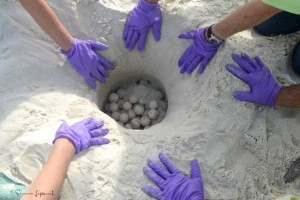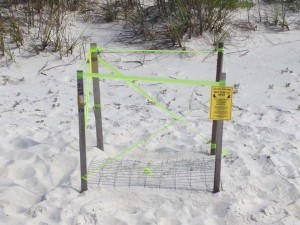 During the months of May to October, we share our Alabama beaches with visitors of a different sort: the nesting sea turtle. In 2014, nearly 7,000 of our underwater friends were hatched along the shores from Dauphin Island and Fort Morgan to Gulf Shores and Orange Beach. During these perilous few months for sea turtles and their nests, the Share the Beach program urges residents and visitors alike to help Mother Nature by being aware of our nesting neighbors.
During the months of May to October, we share our Alabama beaches with visitors of a different sort: the nesting sea turtle. In 2014, nearly 7,000 of our underwater friends were hatched along the shores from Dauphin Island and Fort Morgan to Gulf Shores and Orange Beach. During these perilous few months for sea turtles and their nests, the Share the Beach program urges residents and visitors alike to help Mother Nature by being aware of our nesting neighbors.
There are three types of sea turtles that make the Alabama Gulf Coast a nursery for their eggs: loggerhead, Kemps ridley and green. Loggerheads are the most common found on Alabama’s shoreline. Kemps ridley turtles are rare on Alabama’s beaches and you’ll only find a couple nesting on the Alabama Gulf Coast each year. While loggerheads nest and hatch at night, Kemps ridleys are daytime nesters. It’s even rarer to find a green sea turtle nesting on Alabama’s coastline. In 2014, a green sea turtle attempted to nest, but was deterred by beach chairs and umbrellas. Kemps ridleys are listed as endangered, while the loggerheads and greens are a cause for concern due to over-harvesting, as well as being caught in fishing and shrimping nets, loss of suitable nesting habitat, ingestion of marine debris and boat strikes. All three species are protected under the Federal Endangered Species Act.
 Female turtles return to lay their eggs near the same beach where they hatched. Incubation periods for turtle eggs range from 48 to 75 days, depending on the temperature of the beach. Cooler weather means a longer incubation period. Temperature also determines the gender of the hatchlings, with warmer temperatures producing females and cooler temperatures producing males. There can also be temperature differences in the nest itself. Hatchlings emerge from the nests and make a frenzied race toward the Gulf of Mexico.
Female turtles return to lay their eggs near the same beach where they hatched. Incubation periods for turtle eggs range from 48 to 75 days, depending on the temperature of the beach. Cooler weather means a longer incubation period. Temperature also determines the gender of the hatchlings, with warmer temperatures producing females and cooler temperatures producing males. There can also be temperature differences in the nest itself. Hatchlings emerge from the nests and make a frenzied race toward the Gulf of Mexico.
Share the Beach volunteers are trained to locate turtle crawls indicating where nests are located. When a nest is found, volunteers stake and mark the area so it will remain undisturbed. Some volunteers return as nest sitters while others mitigate artificial light pollution by digging trenches between the nest and water or building silt fences. One goal of Share the Beach volunteers is to get the hatchlings out to the relative safety of open water. In addition, Share the Beach also promotes awareness and conservation of sea turtles through public education and outreach.
Do you want to know how you can help during your Gulf Shores and Orange Beach vacation? These five easy ways allow you to be sea turtle-friendly and help ensure the longevity of our underwater friends.
1. Do not disturb sea turtle nests marked on the beach. It is a Federal offense to disturb either nests or sea turtles.
2. Minimize outdoor lighting as much as possible and don’t use flash cameras on the beach during nesting season. Turn off balcony lights and close curtains and blinds to keep light from shining on the beach. When walking the beach or sand crabbing at night, use red flashlights or red flashlight covers.
3. Don’t leave your beach gear – such as umbrellas, tents, chairs and coolers – on the beach at night. These items can discourage or injure a sea turtle from nesting. In addition, clear your trash when you leave the beach. Your trash could cause the death of a sea turtle if she ingests the garbage. You should also fill in any holes that were dug. Holes can injure both turtles and people.
4. If you see a sea turtle on the beach at night, leave it alone. No photos, please. Female sea turtles may not nest if disturbed. And, remember, it’s a Federal offense to disturb these nesting neighbors.
5. Adopt a nest. Funds raised through the Adopt a Nest program are used to purchase new equipment, as well as provide education to the public.
If you spot a sea turtle during your family beach vacation and you don’t see Share the Beach volunteers nearby in green T-shirts, notify the Share the Beach program at 866-Sea-Turtle.


